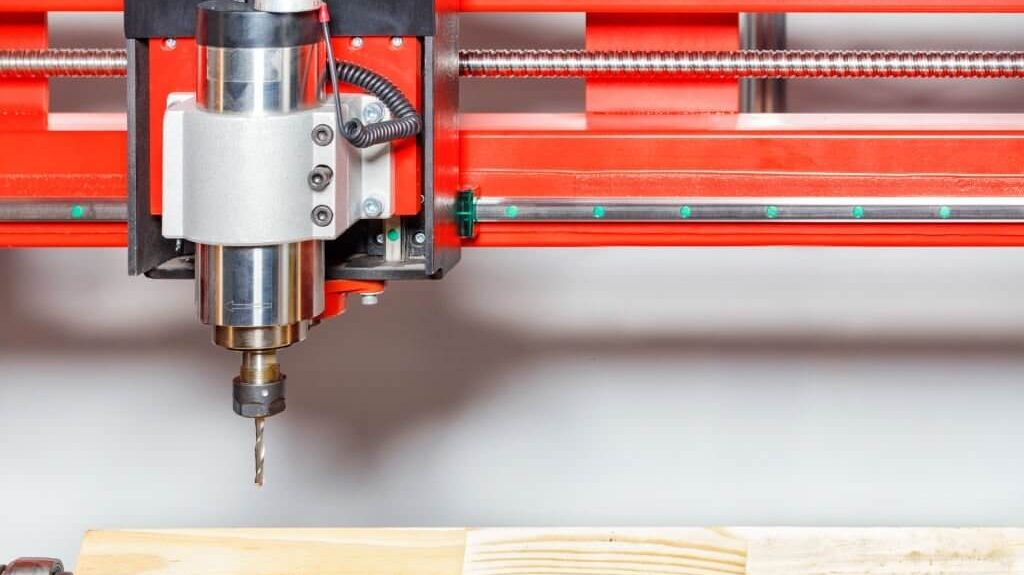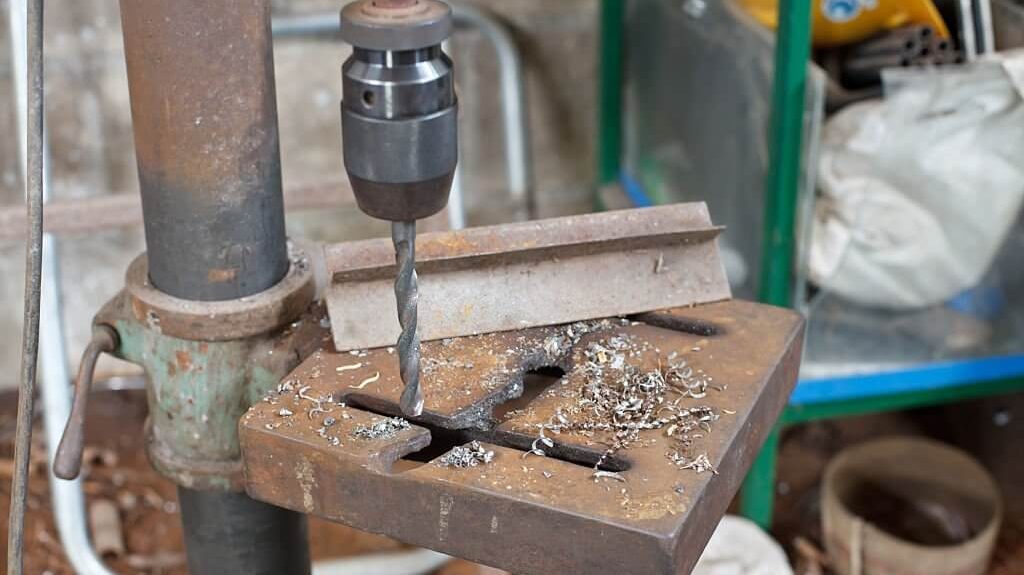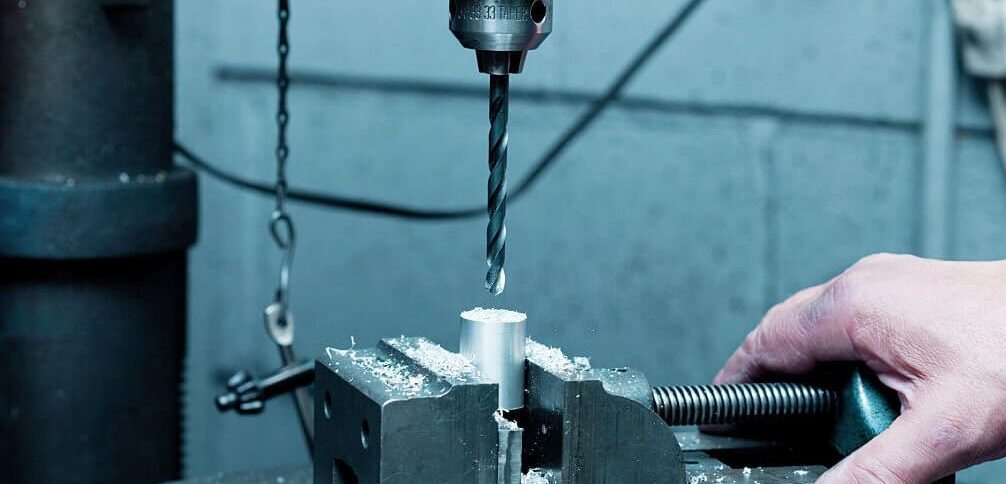How to bore a cylinder with a drill press is a great resource if you want to add accuracy and precision to your projects. The best method for finishing the task may involve using a drill press.
It provides greater control than a handheld drill when drilling into materials, significantly lowering the chance of making mistakes as a result of inaccurate measurements.
Did you know that with the right setup and technique, it’s possible to use even an entry-level drill press for boring cylinders or holes? In this post, we will walk you through all of the steps needed in order to achieve perfect bores on your cylinder pieces every time!
Cylinder With a Drill Press – Easy Steps
Boring a cylinder is an important task in the manufacturing process and can be done relatively easily from your own workshop. Here’s what you’ll need: a drill press, an adjustable boring bar, and high-speed steel or carbide-cutting tools.
Step 1:
Secure the workpiece to the drill press table. Use a clamp or other secure method of fastening to ensure it does not move when drilling begins.
Step 2:
Select an appropriate cutting hole tool and adjust the boring bar to what is needed for the specific job. During this step, you should also inspect all the working parts of the drill press to make sure all are functional and ready for use.
Step 3:
Adjust the quill so that it is below the table’s surface. You can then start drilling at a low speed with light pressure, gradually increasing to find the correct depth for your cylinder bore.
Step 4:
Slowly rotate the cutting tool while feeding it into the cylinder to bore at a consistent depth. Make sure that the feed rate and speed are correct so as not to overheat or damage the workpiece.
Step 5:
Once you have reached the required depth, stop drilling and remove the cutting tool from the drill press. This will prevent any further damage from occurring to the workpiece.
Step 6:
Inspect the drilled cylinder bore for accuracy and smoothness. Adjust any cutting tools or boring bars if needed, and repeat steps 3-5 until you have achieved a satisfactory result.
Congratulations! You’ve successfully bored a cylinder with your drill press. With some practice, you’ll be able to achieve a professional result every time.
What Tool Is Used to Bore Cylinders?
The tool commonly used to bore cylinders is called a cylinder boring machine or a cylinder boring bar. It is a specialized machine or tool designed specifically for the purpose of enlarging or refinishing the bore of a cylinder.

A cylinder boring machine typically consists of a sturdy frame or base, a rotating cutting head, and a system for clamping and securing the cylinder. The cutting head is equipped with multiple cutting tools, known as boring bits or cutters, that are designed to remove material from the cylinder wall.
The operator of the cylinder boring machine sets the desired specifications for the bore diameter and feeds the cutting head into the cylinder while it is securely held in place.
The rotating cutting tools gradually remove material from the cylinder wall, enlarging the bore or creating a smoother surface. This process is repeated until the desired correct bore size and finish are achieved.
Cylinder boring machines are commonly used in automotive engine rebuilding, where worn or damaged cylinders are reconditioned to restore optimal performance.
They can also be used in other applications, such as in the manufacturing of hydraulic cylinders, engine blocks, or other cylindrical components.
It’s important to note that cylinder boring is a precision operation that requires expertise and specialized equipment. It is typically performed by professionals in machine shops or engine rebuilding facilities to ensure accurate and high-quality results.
Which Drill Press Drill Bits Bore Cylinders Best?
When drilling into a cylinder with a drill press you will need to use the correct type of drill bit for the job. The most commonly used bits are either twist drills or Forester bits. Twist drills work well when there’s no need for accuracy, but they can leave “pilot holes” that will make it difficult to line boring up the next drill bit.

Forester bits are more precise and will leave a cleaner, more accurately sized hole in your material. However, they’re much slower than twist drills and require more attention to keep them running straight and true.
If accuracy is critical for your project, or if you’re drilling into thicker material, you may want to consider using a step drill bit.
Step drill bits can be used to accurately bore through thick material without the need for multiple pilot holes. They are also able to penetrate hard materials such as brass and stainless steel with ease.
No matter which type of drill bit you choose, it’s important to make sure that it is sharp and that you are running the drill press at a slow speed to ensure accurate results.
When drilling into metal or hard materials, be sure to use a lubricant such as cutting oil to reduce friction and prevent heat build-up. Additionally, be sure to wear proper safety gear when using a drill press and always keep your hands and body away from the spinning bit.
With the correct drill bit and safety precautions, you will be able to quickly and accurately bore through a cylinder with your drill press.
How to Select a Bore Size for the Cylinder?
When selecting an appropriate bore size for the cylinder, it is important to consider the weight of the load that will be moved by the cylinder. The heavier the load, the larger diameter cylinder should be used.
Another factor to consider is the speed at which you want to move your load. A bigger bore size means more oil flow and thus more speed.
Lastly, consider the space constraints in which you are working. A large bore size range will mean a bigger cylinder and more space needed, while smaller bores can be used for applications with tight spaces.

The decision should ultimately come down to what meets your requirements in terms of load weight, speed, and space availability.
By weighing these factors and understanding the capabilities of each cylinder size, you can make an informed decision on the best bore size for your application. This will help ensure that your system works safely and efficiently.
What is the Difference Between Honing and Boring a Cylinder?
1. Honing
Honing and boring are two techniques used to shape the interior of cylinders. Honing is a type of precision grinding that produces an even, circular surface texture on the walls of the cylinder. This helps to create smoother walls that reduce friction and minimize engine wear.
2. Boring
Boring is a machining process in which an existing hole is enlarged with a tool. Boring is used to increase the size of existing cylinder holes, usually for engine repair or improvement. Both honing and boring are important processes in engineering, manufacturing, automotive, and other industries that use cylinders.
The main difference between the two is that honing creates a new finish on an existing bore while boring entirely removes material from the hole to enlarge it. The choice between honing and boring for a particular application will depend on the size of the bore, its precise location, and how much material needs to be removed.
What is Cylinder Reaming?
Cylinder reaming is a machining process used in engineering and manufacturing industries to create a precise, cylindrical hole in materials like steel and aluminum. A reamer is a special type of cutting tool used to finish the interior surface of the cylinder hole to exact dimensions.
This process can also be used to produce a polished and uniform surface finish on the inside surface of the hole, as well as improve the concentricity and roundness of the bore.
Reaming is an important manufacturing process that helps to create precision parts and components for automobiles, aircraft, ships, and other machines that require precise cylindrical holes.

It is also used extensively in medical instrument manufacturing due to its accuracy and ability to create smooth surfaces. Cylinder reaming requires skilled machinists and specialized reaming tools, making it a highly specialized process that is often outsourced to professional machining services.
What is the Cylinder Bore Ratio?
The cylinder bore ratio is a metric used to measure the diameter of an internal combustion engine’s cylinder relative to its stroke length. The bore/stroke ratio is calculated by dividing the cylinder bore diameter in millimeters or inches, by the piston stroke length.
A higher ratio indicates greater power potential than lower ratios, and a lower ratio often results in improved fuel economy. The cylinder bore ratio can be used to determine the size of an engine, and also help classify the style of an engine.
For example, engines with low bore/stroke ratios are generally referred to as ‘over square’ or ‘short stroke’ engines, while those with high ratios are known as ‘under square’ or ‘long stroke’. The cylinder bore ratio is an important factor to consider when making decisions about engine tuning and modifications.
By modifying the cylinder bore ratio, it is possible to achieve desired power output levels while also optimizing fuel efficiency.
Bore a Cylinder With a Drill Press FAQs
What Should be the Bore Size for a Cylinder?
The distance between the piston and cylinder must preferably have at least the desired application. In fact, the bore size is determined by a specific hydraulic requirement of an engine.
Can I Use a Boring Head in a Drill Press?
It allows the installation of several different drilling boring heads and may use drills or manual power tools.
Can you Bore your Own Cylinder?
During the use of the engine the cylinder wears, as friction stress is causing damage to the motor. A bore in a motor cylinder will remove debris which can accumulate after long usage.
Boring engines must be supervised by a qualified mechanic, as a sloppy job could be disastrous for many users.
Conclusion
Now that you know the basics of boring a cylinder with a drill press, it’s time to give it a whirl yourself! Just remember to always use caution when operating any type of power tool and wear all necessary protective gear. Additionally, practice drilled holes in scrap pieces of wood before tackling the final project.
With enough patience and knowledge, you can master this task in no time! It’s amazing what one small piece of equipment can do for your home renovations, not to mention the satisfaction that comes with creating something completely unique on your own.
So grab your drill presses, find an appropriate spot for them on your workbench, and start crafting the projects you’ve been dreaming about!




